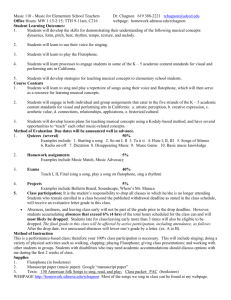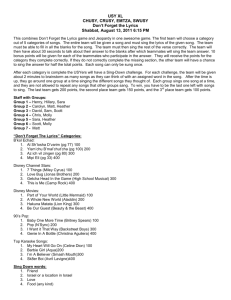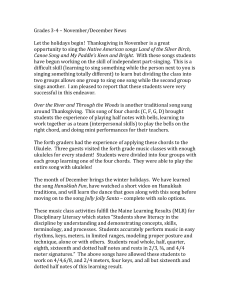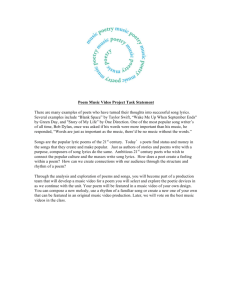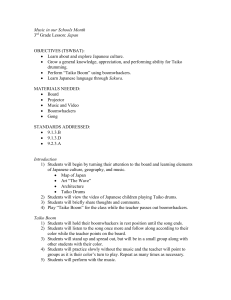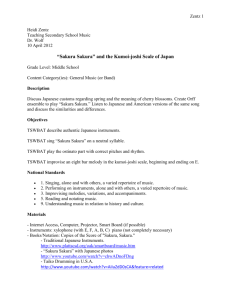Comparing a Japanese and American Folk Song with the inclusion
advertisement
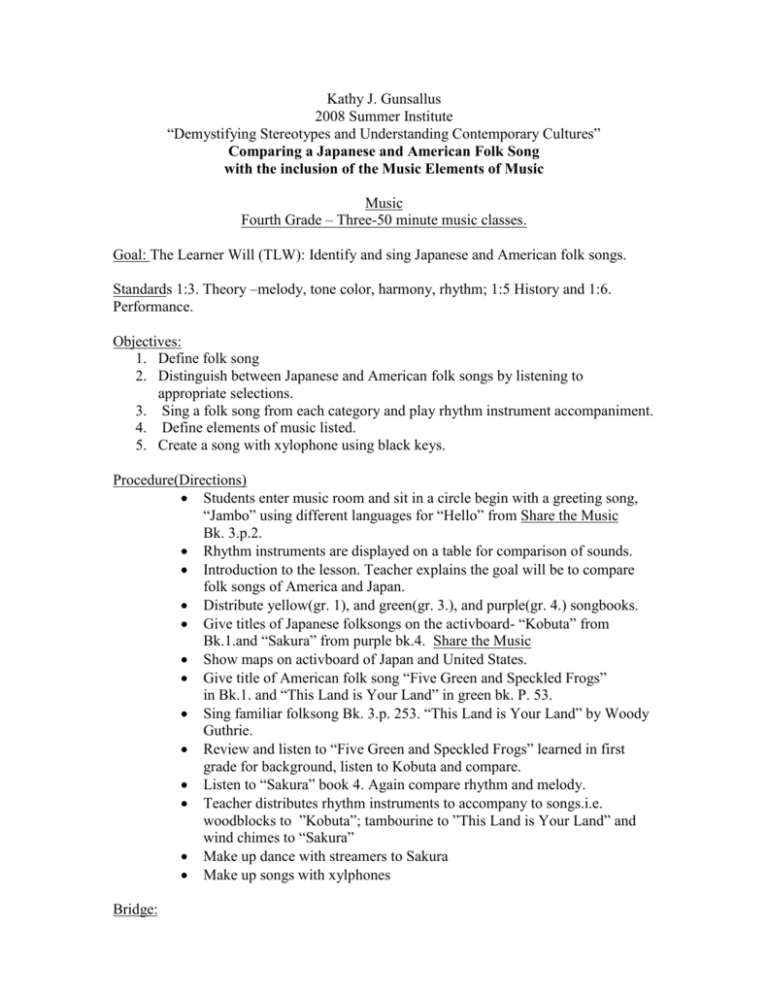
Kathy J. Gunsallus 2008 Summer Institute “Demystifying Stereotypes and Understanding Contemporary Cultures” Comparing a Japanese and American Folk Song with the inclusion of the Music Elements of Music Music Fourth Grade – Three-50 minute music classes. Goal: The Learner Will (TLW): Identify and sing Japanese and American folk songs. Standards 1:3. Theory –melody, tone color, harmony, rhythm; 1:5 History and 1:6. Performance. Objectives: 1. Define folk song 2. Distinguish between Japanese and American folk songs by listening to appropriate selections. 3. Sing a folk song from each category and play rhythm instrument accompaniment. 4. Define elements of music listed. 5. Create a song with xylophone using black keys. Procedure(Directions) Students enter music room and sit in a circle begin with a greeting song, “Jambo” using different languages for “Hello” from Share the Music Bk. 3.p.2. Rhythm instruments are displayed on a table for comparison of sounds. Introduction to the lesson. Teacher explains the goal will be to compare folk songs of America and Japan. Distribute yellow(gr. 1), and green(gr. 3.), and purple(gr. 4.) songbooks. Give titles of Japanese folksongs on the activboard- “Kobuta” from Bk.1.and “Sakura” from purple bk.4. Share the Music Show maps on activboard of Japan and United States. Give title of American folk song “Five Green and Speckled Frogs” in Bk.1. and “This Land is Your Land” in green bk. P. 53. Sing familiar folksong Bk. 3.p. 253. “This Land is Your Land” by Woody Guthrie. Review and listen to “Five Green and Speckled Frogs” learned in first grade for background, listen to Kobuta and compare. Listen to “Sakura” book 4. Again compare rhythm and melody. Teacher distributes rhythm instruments to accompany to songs.i.e. woodblocks to ”Kobuta”; tambourine to ”This Land is Your Land” and wind chimes to “Sakura” Make up dance with streamers to Sakura Make up songs with xylphones Bridge: 1. Various cultures use folksongs for entertainment. The songs we learned today are examples of folksongs. How have you experienced the use of folksongs in your family’s life? Discuss answers. Suggestion might be, do you sing in your car? 2. If there are children whose family came from Japan ask them – privately before the lesson- if they would share a song or a story they may have learned from their parents. Compare with a child of American background. 3. Have a parent visit and talk about customs, food, hobbies, etc. 4. Fourth grade reads Japanese novels, and writes Haiku that could be coordinated with this lesson. 5. Compare pictures of Japanese rhythm instruments and American rhythm instruments. Closure: Folksongs are songs made up by people for work, entertainment and daily life. Assessment: 1. Teacher chooses and plays different selections of Japanese and American music; students will hold up a picture of a map of Japan or America for their answer that matches the appropriate country. 2. Using the activboard, utilize activote by having pictures of the maps of Japan and America on the Activboard, then students can enter their vote electronically. Each keeps his or her own score of correct answers. 3. Students could make up their own folk song using the black keys on the xylophone Materials: Song books from Share the Music series and correlating CD’s Rhythm instruments: Tambourine Tone Blocks Wind chimes Xylophones Streamers and or scarves Activboard Laptop cart popsicle sticks copies of maps of America and Japan glue scissors Websites: Youtube”Sakura- Japanese folk song – Cherry Blossom Song http://www.cellularabroad.com/japanmap.html http://www.youtube.com/watch?v=bxTVX0y_GU&feature=relatedwww.youtube.com/watch?v=LKPosU3J0FI


